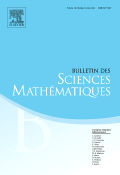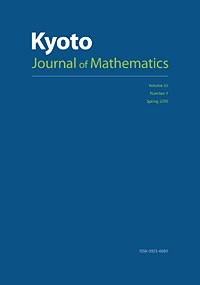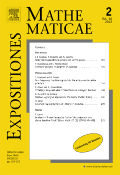
BULLETIN DES SCIENCES MATHEMATIQUES
Scope & Guideline
Exploring the Depths of Mathematical Innovation
Introduction
Aims and Scopes
- Functional Analysis and Operator Theory:
The journal frequently publishes papers that delve into functional analysis, particularly focusing on operator theory. This includes explorations of bounded linear operators, pseudo-differential operators, and their applications in various mathematical contexts. - Fractional Calculus and Differential Equations:
A significant portion of the research highlights fractional calculus, including fractional differential equations and their applications in modeling real-world phenomena. The journal features studies that analyze existence, stability, and control of solutions to these equations. - Algebraic Geometry and Topology:
Research in algebraic geometry and topology is prominently featured, including studies on moduli spaces, vector bundles, and other geometric structures. The journal emphasizes the interplay between algebra and geometry, often addressing complex varieties and their properties. - Harmonic Analysis and PDEs:
The journal showcases a variety of papers on harmonic analysis, particularly involving singular integral operators and their applications to partial differential equations (PDEs). This includes the study of weighted spaces and the behavior of solutions under various conditions. - Mathematical Physics and Quantum Computing:
Emerging themes in mathematical physics, particularly in quantum computing and related algorithms, are increasingly present in the journal. This reflects a growing interest in the application of mathematical principles to problems in physics and computational science.
Trending and Emerging
- Nonlinear Dynamics and Bifurcation Theory:
Recent publications have increasingly explored nonlinear dynamics and bifurcation theory, highlighting their relevance to both pure and applied mathematics. This trend reflects a broader interest in understanding complex systems and their behaviors. - Stochastic Analysis and Control Theory:
There is a rising trend in research related to stochastic analysis, particularly in the context of control theory and stochastic differential equations. This reflects an increasing recognition of the importance of randomness in mathematical modeling. - Geometric Analysis and PDEs:
Papers focusing on geometric analysis, particularly involving partial differential equations, have become more prevalent. This trend underscores the interplay between geometry and analysis, particularly in understanding geometric flows and curvature. - Applications of Machine Learning in Mathematics:
An emerging theme is the application of machine learning techniques to solve mathematical problems. This includes the development of algorithms and models that leverage statistical methods to address complex mathematical inquiries. - Mathematical Biology and Ecology:
Research at the intersection of mathematics and biology, particularly in modeling ecological systems and biological processes, is on the rise. This trend highlights the growing importance of mathematical modeling in understanding biological phenomena.
Declining or Waning
- Classical Real Analysis:
There is a noticeable decline in papers focusing on classical real analysis topics, such as traditional limit theorems and basic convergence theorems. This may indicate a shift towards more complex or applied areas of analysis. - Elementary Number Theory:
Research in elementary number theory has decreased in recent years, with fewer papers addressing fundamental topics such as prime distributions or modular forms. This decline suggests a pivot towards more advanced or abstract branches of mathematics. - Combinatorial Geometry:
The scope of combinatorial geometry appears to be waning, with fewer studies published in this area. As the field evolves, researchers may be focusing on more integrated approaches that combine geometry with other mathematical disciplines. - Classical Algebraic Structures:
The journal has seen a reduction in papers focused on classical algebraic structures, such as groups and rings in isolation. This could indicate a trend towards exploring more complex algebraic systems or their applications in other fields.
Similar Journals

Complex Analysis and Operator Theory
Elevating Mathematical Discourse and DiscoveryComplex Analysis and Operator Theory, published by Springer Basel AG, is a renowned journal in the field of applied and computational mathematics, reflecting a strong engagement with contemporary mathematical challenges. With an ISSN of 1661-8254 and E-ISSN 1661-8262, this journal provides a platform for disseminating significant findings and innovative methodologies that contribute to the advancement of complex analysis, operator theory, and their diverse applications. As a valuable resource for researchers and practitioners alike, it features high-quality peer-reviewed articles that rigorously explore both theoretical and practical aspects of mathematics. Although it currently does not offer open access, readers can access its insightful content through institutional subscriptions or individual purchases. Since its inception in 2007, the journal has carved a niche for itself, evidenced by its placement in the Q2 quartiles in both Applied Mathematics and Computational Mathematics, and its recognition in Computational Theory and Mathematics. With an ambitious goal to foster the dialogue between theory and practice, Complex Analysis and Operator Theory continues to support the mathematical community from its base in Basel, Switzerland.

Kyoto Journal of Mathematics
Exploring the depths of mathematical discovery and excellence.Kyoto Journal of Mathematics is a premier academic publication dedicated to advancing the field of mathematics, published by DUKE UNIVERSITY PRESS. Established in 1996, this journal serves as a vital platform for sharing innovative research and breakthrough studies across various mathematical disciplines. The journal has consistently maintained a prestigious Q1 ranking in the category of Mathematics (miscellaneous) as of 2023, reflecting its significant impact and contribution to the mathematical community. With its Open Access policy, the Kyoto Journal of Mathematics ensures that groundbreaking research is easily accessible to a global audience, fostering collaboration and knowledge dissemination among researchers, professionals, and students alike. The journal's commitment to excellence and relevance in mathematical research is underscored by its extensive archive of published works and its continuous engagement with contemporary mathematical challenges. This makes the journal an essential resource for anyone seeking to stay abreast of current trends and advancements in the field.

ACTA SCIENTIARUM MATHEMATICARUM
Elevating Understanding through Rigorous ResearchACTA SCIENTIARUM MATHEMATICARUM, published by SPRINGER BIRKHAUSER in Switzerland, is a distinguished journal focusing on the fields of mathematical analysis and applied mathematics. With an ISSN of 0001-6969 and an E-ISSN of 2064-8316, this journal serves as a critical platform for disseminating high-quality research that bridges theoretical and practical aspects of mathematics. Although currently categorized in the Q3 quartile for both Analysis and Applied Mathematics as of 2023, the journal strives to enhance its impact on the mathematical community by offering a perfect blend of rigorous research and innovative applications. Researchers, professionals, and students can benefit from the journal’s commitment to advancing knowledge in mathematics, despite the absence of open-access options. The mailing address for correspondences is 233 SPRING STREET, 6TH FLOOR, NEW YORK, NY 10013. As mathematics continues to evolve, ACTA SCIENTIARUM MATHEMATICARUM positions itself as a valuable resource for those looking to contribute to and stay informed about the latest developments in this vibrant field.

INTERNATIONAL JOURNAL OF MATHEMATICS
Bridging Ideas Across the Mathematical LandscapeInternational Journal of Mathematics, published by World Scientific Publishing Co Pte Ltd, is a leading academic journal dedicated to advancing research in the field of mathematics. With an ISSN of 0129-167X and an E-ISSN of 1793-6519, this journal provides a platform for the dissemination of high-quality mathematical research and fosters academic discourse among mathematicians and professionals worldwide. Operating out of Singapore, International Journal of Mathematics boasts a respectable Q2 ranking in the 2023 Mathematics (miscellaneous) category, indicating its commitment to impactful scholarship. The journal publishes articles that cover a broad spectrum of mathematical topics, ensuring valuable insights for researchers, educators, and students alike. Despite not being an open-access journal, it maintains accessibility through established university and institutional subscriptions, furthering its influence in the mathematical community. The journal has continually evolved since its inception in 1996 and will continue to be a crucial resource for insightful mathematical explorations until at least 2024.

Pure and Applied Mathematics Quarterly
Pioneering Insights in Pure and Applied MathematicsPure and Applied Mathematics Quarterly is a prestigious journal published by INT PRESS BOSTON, INC, focusing on the diverse and evolving field of mathematics. Since its inception in 2007, this journal has grown significantly, currently holding a Q1 ranking in the Mathematics (Miscellaneous) category for 2023, positioning it among the leading publications in the discipline. With a commitment to publishing high-quality research, Pure and Applied Mathematics Quarterly fosters innovation and dialogue within the mathematical community by providing a platform for theoretical advancements and practical applications. The journal remains accessible to researchers and professionals through its ISSN 1558-8599 and E-ISSN 1558-8602, although it does not currently offer open access. As a vital resource for mathematicians, educators, and students, this journal endeavors to expand the frontiers of mathematical knowledge and contribute to the academic dialogue surrounding this fundamental science.

EXPOSITIONES MATHEMATICAE
Championing Excellence in Mathematical ScholarshipEXPOSITIONES MATHEMATICAE, published by Elsevier GmbH, stands as a significant journal in the realm of mathematics, catering primarily to researchers, professionals, and students. With an ISSN of 0723-0869 and an E-ISSN of 1878-0792, this journal has made its mark in the academic community, boasting a Q2 classification in the miscellaneous mathematics category for 2023, illustrating its prominence within its field. The journal addresses a diverse scope of mathematical topics, encouraging the publication of original research and innovative theories while maintaining rigorous academic standards. As it converges from 2004 to 2024, EXPOSITIONES MATHEMATICAE continues to be an essential resource for advancing mathematical knowledge and fostering scholarly communication, despite being a non-open-access publication. Its location in Munich, Germany further anchors it within a rich intellectual tradition, providing accessibility for the mathematical community worldwide.

Bulletin Mathematique de la Societe des Sciences Mathematiques de Roumanie
Connecting Scholars through High-Quality Mathematical DiscourseThe Bulletin Mathematique de la Societe des Sciences Mathematiques de Roumanie, published by SOC MATEMATICE ROMANIA, is a distinguished platform dedicated to the dissemination of advanced mathematical research and developments. With ISSN 1220-3874 and E-ISSN 2065-0264, this journal serves the global mathematical community, particularly in Romania, fostering collaboration and innovation in varied mathematical disciplines. Despite being categorized in the Q3 quartile of the *Mathematics (miscellaneous)* field and holding a Scopus rank placing it in the 19th percentile, the journal remains committed to publishing high-quality articles that explore theoretical and applied mathematics. Running from 2008 to 2024, it aims to encourage the sharing of knowledge and advancements within both academic and practical domains, affirming its importance as a valuable resource for researchers, professionals, and students alike. Although the journal does not currently offer open access, it contributes to the mathematical discourse through the rigorous selection of papers that adhere to high scholarly standards.

REVUE ROUMAINE DE MATHEMATIQUES PURES ET APPLIQUEES
Exploring the Depths of Mathematical KnowledgeREVUE ROUMAINE DE MATHEMATIQUES PURES ET APPLIQUEES, published by EDITURA ACAD ROMANE, is a significant scholarly journal in the field of mathematics, with a focus on both pure and applied aspects. Established in 1974 and running continuously, it has become a vital platform for researchers in Romania and worldwide. The journal operates under the ISSN 0035-3965 and E-ISSN 2343-774X, contributing to the academic resources available in mathematics and related disciplines. With a current classification as Q4 in both applied and miscellaneous mathematics, it provides a unique opportunity for scholars to disseminate their findings and engage with the broader mathematical community. Although the journal currently does not offer open access, it continues to maintain its presence and relevance within the Scopus rankings, underscoring its important role in academic discourse. Researchers, professionals, and students alike will find valuable insights and developments in the pages of REVUE ROUMAINE DE MATHEMATIQUES PURES ET APPLIQUEES, which is committed to advancing the understanding of mathematical theories and applications in various fields.

PUBLICATIONS OF THE RESEARCH INSTITUTE FOR MATHEMATICAL SCIENCES
Championing High-Quality Research in MathematicsPublications of the Research Institute for Mathematical Sciences, ISSN: 0034-5318, E-ISSN: 1663-4926, is a distinguished academic journal published by the European Mathematical Society. Since its inception in 1969, this journal has emerged as a pivotal platform for disseminating high-quality research in the field of mathematics, achieving a notable position in the top quartile (Q1) of the Mathematics (miscellaneous) category as of 2023. With a current Scopus Rank of #121 out of 399, placing it within the 69th percentile for general mathematics, the journal serves as an essential resource for researchers, professionals, and students alike. It aims to foster the advancement of mathematical science through innovative research and comprehensive studies that encourage scholarly dialogue and collaboration. While access options may vary, the journal remains committed to enhancing the visibility and impact of mathematics research on a global scale. Based in Germany, at the Technische Universität Berlin, it continues to uphold a legacy of academic excellence and rigor in mathematical inquiry.

Kragujevac Journal of Mathematics
Pioneering Discoveries in Mathematics Since 2000.The Kragujevac Journal of Mathematics, an esteemed publication since its inception in 2000, is a premier open access journal dedicated to advancing the field of mathematics. Published by the University of Kragujevac, Faculty of Science in Serbia, this journal has garnered recognition for its rigorous academic standards and substantial contributions to mathematical research, achieving a 2023 category quartile ranking of Q2 in Mathematics (miscellaneous). With a commendable Scopus rank of #81 out of 399 in general mathematics, it consistently features innovative and original research papers that explore a broad spectrum of mathematical disciplines. The journal’s commitment to open access ensures that its research is readily available to the global community, fostering collaboration and knowledge sharing among scholars, professionals, and students. By providing a platform for high-quality research, the Kragujevac Journal of Mathematics plays a vital role in shaping contemporary mathematical discourse and inspiring new generations of mathematicians.